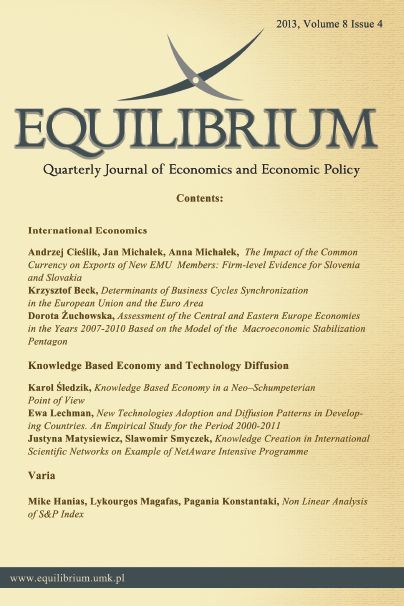New Technologies Adoption and Diffusion Patterns in Developing Countries. An Empirical Study for the Period 2000-2011
DOI:
https://doi.org/10.12775/EQUIL.2013.028Keywords:
information and communication technologies, adoption patterns, technology diffusion, S-shaped curve, developing countriesAbstract
In recent years, enormous changes are noted worldwide during broad adoption of Information and Communication Technologies (ICT). These unique technologies ? often perceived as economic development incentives ? have a great ability to spread at high pace and low cost in countries all over the world, bringing people opportunities to contribute to economic development and growth. New Technologies play a special role in developing countries, where their in-country adoption lies in the centre of development strategies. ICT are treated as tools which bring people access to information, education and knowledge, offering unlimited possibilities for wealth-creation. The paper, purely empirical in nature, reports on the pace of adoption of new Information and Communication Technologies in developing countries, and ? additionally ? investigates country-specific ICT diffusion patterns. We expect to uncover the S-shape curve in the diffusion process in most of developing countries, as well as in the whole country sample. For the analysis purposes, we apply all counties which ? according to the World Bank nomenclature ? are classified as low-income and lower-middle-income econ- omies. Our sample covers 46 countries (upper-middle-income and high-income economies are excluded from the study purposefully) which are classified as developing economies. The time framework is set for the period of 2000-2011. All data necessary for the analysis are derived from World Telecommunication/ICT Indicators Database 2012 (16th edition).
Downloads
References
Baliamoune-Lutz M. (2003), An analysis of the determinants and effects of ICT diffusion in developing countries, ?Information Technology for Development?, Vol. 10, http://dx.doi.org/10.1002/itdj.1590100303.
Billon M., Lera-Lopez F., Marco R. (2010), Differences in digitalization levels: a multivariate analysis studying the global digital divide, ?Review of World Economy?, Vol. 146, http://dx.doi.org/10.1007/s10290-009-0045-y.
Chong A., Micco A. (2003), The Internet and the ability to innovate in Latin America, ?Emerging Markets Review?, Vol. 4, http://dx.doi.org/10.1016/S1566- 0141(02)00063-8.
Comín D., Hobijn B. (2003), Cross-Country Technology Adoption: Making the Theories Face the Facts, Paper prepared for the Carnegie Rochester Conference on Public Policy.
Darwin C. (1859), The origin of species, John Murray, London.
Dasgupta P., Stoneman P. (2005), Economic Policy and Technological Performance, Cambridge University Press.
De Guio R., Kucharavy D. (2007), Application of S-shaped curves, TRIZ-Future Conference 2007: Current Scientific and Industrial Reality, Frankfurt.
Estache A., Manacorda M., Valletti T.M. (2002), Telecommunications, Reform, Access Regulation, and Internet Adoption in Latin America, ?Economía?, Vol. 2, http://dx.doi.org/10.1353/eco.2002.0003.
Geroski P.A. (2000), Models of technology diffusion, ?Research Policy?, Vol. 29.
Goldfarb A., Prince J. (2008), Internet adoption and usage patterns are different: implications for the digital divide, ?Information Economics and Policy?, Vol. 20, http://dx.doi.org/10.1016/j.infoecopol.2007.05.001.
Gort M., Klepper S. (1982), Time paths in the diffusion of product innovation, ?The Economic Journal?, Vol. 92, http://dx.doi.org/10.2307/2232554.
Gray V. (1973), Innovation in the States. A Diffusion Study, ?The American Political Science Review?, Vol. 67, No. 4, http://dx.doi.org/10.2307/1956539.
Grazzi M., Vergara S. (2008), What drives ICT diffusion in developing countries? Evidence from Paraguay, Division of Production, Productivity and Management, CEPAL, United Nations.
Hobijn B., Comin D. (2003), Cross-country technology adoption: making the theories face the facts, ?Journal of Monetary Economics?, Vol. 51.
Jovanovic B., Lach S. (1989), Entry, Exit, and Diffusion with Learning by Doing, ?American Economic Review?, Vol. 79, No. 4.
Karshenas M., Stoneman P. (1995), Technological diffusion [in:] Stoneman I. (ed.) Handbook of Economic of Innovation and Technological Change, Blackwell. Cambridge.
Keller W. (2001), International technology diffusion, NBER Working Paper 8573.
Klobas J.E., Clyde L.A. (1998), Learning to use the internet in a developing country: validation of a user model, ?Libri?, Vol. 48.
Mansfield E. (1961), Technical Change and the Rate of Imitation, ?Econometrica?, Vol. 29, No. 4, http://dx.doi.org/10.2307/1911817.
Lechman E. (2012), Catching-up and club convergence from cross-national perspective. A statistical study for the period 1980-2010, ?Equilibrium. Quarterly Journal of Economics and Economic Policy?, Vol.7, No. 3.
Lechman E. (2012), Technology convergence and digital divides. A country-level evidence for the period 2000?2010, ?Ekonomia. Rynek, gospodarka
Mansfield E. (1968), The economics of technological change, W.W Norton& Company Inc., New York.
Metcalfe J.S. (1988), The diffusion of innovation: an interpretive survey [in:] G. Dosi et al.(ed.), Technological Change and Economic Theory, Pinter, London.
Modis T. (2007), From my perspective. Strengths and weaknesses of S-curves, ?Technology Forecasting & Social Change?, Vol. 74.
Rogers M.E. (1962), Diffusion of innovation, The Free Press, London.
Romero Ania A., Alonso Neira M.A., Blanco Jimenez F.J., Fernandez-Cano E. del A. (2012), Modelling and prediction of Internet diffusion in the African continent: the s-shaped Internet diffusion curve, Proceedings 25th European Conference on Modelling and Simulation ECMS, Burczyński T., Kołodziej J., Byrski A., Carvalho M. (ed.).
Quibria M.G., Ahmed S.N., Tschang T., Reyes-Macasaquit M.L. (2002), Digital Divide: Determinants and Policies with Special Reference to Asia, ?Economics and Research Department Working Paper?, No. 27, Asia Development Bank, Manila, http://dx.doi.org/10.1016/S1049-0078(02)00186-0.
Sahin I. (2006), Detailed review of Roger`s diffusion of innovation theory and educational technology-related studies based on Roger`s theory, ?The Turkish Online Journal of Educational Technology?, Vol. 5, No. 2.
Sarkar J. (1998), Technological diffusion: alternative theories and historical evidence, ?Journal of Economic Surveys?, Vol. 12, No.2, http://dx.doi. org/10.1111/1467-6419.00051.
Schumpeter J.A. (1934), Theory of economic development, Transaction Publishers.
Schumpeter J.A. (1947), The creative responses in economic history, ?Journal of Economic History?, Vol. 7.
Shimogawa S., Shinno M., Saito H. (2012), Structure of S-shaped growth in innovation diffusion, ?Physical Review?, Vol. 85, http://dx.doi.org/ 10.1103/PhysRevE.85.056121.
Soete L., Verspagen B. (1993), Technology and growth: the complex dynamics of catching-up, falling behind and taking over, ?Explaining Economic Growth?, (http://ideas.repec.org/p/ner/maastr/urnnbnnlui27-6312.html).
Stoneman P. (2001), The economics of technological diffusion, Blackwell, Oxford. Udo G., Bagchi K.K., Kirs P.J. (2008), Diffusion of ICT in developing countries: a qualitative differential analysis of four nations, ?Journal of Global Information Technology Management?, Vol. 11, No. 1.






